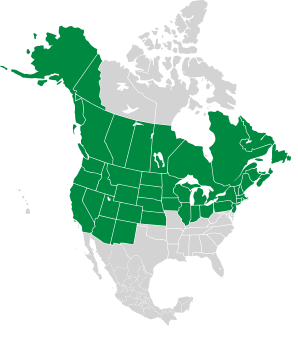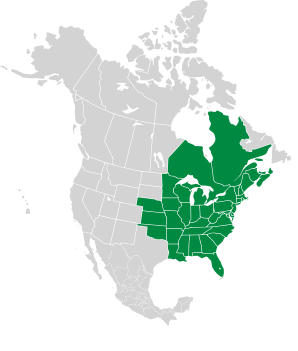Actaea alba auct. non (L.) Mill.

|
Actaea pachypoda Elliott White baneberry, doll’s eyes
Baneberries are members of the buttercup family. They are natives of eastern North America, and live in shady wooded areas. I usually see individual plants, not clusters. Plants: These highly poisonous plants are fairly common in eastern North American forests. They are 1½-2½′ high ⨉ 2-3′ around (45-76 ⨉ 60-91 cm). Stems are hairless. In addition to this white-berried variety, red baneberries have rounder flower clusters, vs. the more cone-shaped cluster in white baneberries. Leaves: Saw-toothed leaves are in groups of three, sometimes five, on thin stems. Leaflets are up to 4 ⨉ 2″ (10 ⨉ 5 cm). Flowers: White flowers occur in a round or cylindrical cluster 1½″ (3.8 cm) around and 1-3″ (2.5-7.6 cm) long. Individual flowers are ¼-½″ (6.3-12 mm) in size, with up to 10 narrow petals and a whole lot of long white stamens. They appear from May to June. Fruits: If it is the time of year for them, baneberries’ most distinguishing feature is, well, the berries. Relatively few plants produce white berries, and the small black or purplish dots at one end of each berry led to the common name “doll's eyes.” The stalks supporting the berries are conspicuously colored. Edibility: Some variants are compared below: |
8/14/2015 · Roost Trail, Grafton Notch State Park, Newry, Maine · ≈ 7 × 4½″ (16 × 11 cm) 8/6/2010 · Nashua River Rail Trail, Groton, Massachusetts · ≈ 11 × 7″ (28 × 18 cm) |
||||||||||||||||||||||||||||
|
| |||||||||||||||||||||||||||||
| You are here Actaea pachypoda |
Actaea pachypoda f. rubrocarpa |
Actaea rubra |
|||||||||||||||||||||||||||
|---|---|---|---|---|---|---|---|---|---|---|---|---|---|---|---|---|---|---|---|---|---|---|---|---|---|---|---|---|---|
| Common Name |  |
 |
 |
||||||||||||||||||||||||||
| Plant | |||||||||||||||||||||||||||||
| Flowers | Flowerheads of small white flowers are roughly oval in shape. Each flower is ¼″ (6.3 mm) across. | Flowerheads of small white flowers are roughly oval in shape. Each flower is ¼″ (6.3 mm) across. | Feathery flowerheads of small white flowers are roughly oval in shape. Each flower is ¼″ (6.3 mm) across. Flowers have a roselike fragrance. | ||||||||||||||||||||||||||
| Leaves | |||||||||||||||||||||||||||||
| Fruit | White berries supported by red pedicels that are ⅛″ (3 mm) or more in thickness. Berry tips have black-purple spot. | Red berries supported by pedicels that are ⅛″ (3 mm) or more in thickness. Instead of the tomato red of red baneberry, these berries have a more luminous deep magenta color, becoming more purplish with time. | Bright or dark red, oval berries are supported by pedicels that are less than ⅛″ (3 mm) thick. | ||||||||||||||||||||||||||
| Range/ Zones |
|
|
|
||||||||||||||||||||||||||
| Habitats | Actaea racemosa | ||||||||||||||||||||||||||||
| Type | Wild | Wild | Wild | ||||||||||||||||||||||||||
| Occurrence | Common | Rare | Common | ||||||||||||||||||||||||||


Online References:
The Lady Bird Johnson Wildflower Center
The Connecticut Botanical Society's Connecticut wildflowers site
Plants for a Future, a resource and information centre for edible and otherwise useful plants
The USDA Forest Service's Fire Effects Information Database
7/23/2015 · Beaver Brook Conservation Area, Hollis, New Hampshire · ≈ 9 × 6″ (22 × 15 cm) 
8/24/2018 · Old Long Loop, Beaver Brook Conservation Area, Hollis, New Hampshire · ≈ 8 × 12″ (20 × 31 cm) 
8/25/2021 · Tarbox Preserve, Topsham, Maine · ≈ 6 × 3½″ (14 × 9.4 cm) 
Finding this in the woods—and puzzling over it on and off for the next six months—got me interested in wild plants in the first place. · 9/23/2007 · Near Mike & Ellen’s, Milford, Pennsylvania 
7/29/2023 · By Kathleen Williamson 
9/5/2020 · Hedgehog Mountain, Freeport, Maine · ≈ 4½ × 7″ (12 × 18 cm) 
Immature fruit · 7/3/2005 · Pepperell, Massachusetts 
9/25/2017 · Oak Hill, Littleton, Massachusetts · ≈ 4½ × 7″ (12 × 18 cm) 
5/14/2012 · Acton Arboretum, Acton, Massachusetts · ≈ 11 × 7″ (27 × 18 cm) 
The rough-edged leaves are part of the baneberry. · 8/12/2023 · Highlands Trail via Pismire Bluffs Trail, Raymond Community Forest, Raymond, Maine · ≈ 12 × 8″ (31 × 20 cm) 
9/25/2017 · Oak Hill, Littleton, Massachusetts · ≈ 10 × 6″ (24 × 16 cm) 
9/6/2010 · Henry E. Cowdrey Nature Center, Townsend, Massachusetts · ≈ 9 × 6″ (23 × 15 cm) 
Actaea alba auct. non (L.) Mill.
Actaea pachypoda description by Thomas H. Kent, last updated 7 Sep 2023.
© FloraFinder.org. All rights reserved.
8/16/2012 · Mt. Tom State Reservation, Beau Bridge Trail, Holyoke, Massachusetts · ≈ 9 × 6″ (22 × 14 cm) 
8/18/2009 · Nashua River Rail Trail, Groton, Massachusetts · ≈ 11 × 7″ (27 × 18 cm) 
10/6/2021 · Wolfe’s Neck Woods State Park, Freeport, Maine · ≈ 6 × 4″ (15 × 10 cm) 
5/14/2013 · Beaver Brook Assn Conservation Lands, Rte. 130, Hollis, New Hampshire · ≈ 8 × 6″ (20 × 14 cm) 
8/31/2023 · Rines Forest, Cumblerland, Maine · ≈ 15 × 10″ (39 × 26 cm) 
5/14/2013 · Beaver Brook Assn Conservation Lands, Rte. 130, Hollis, New Hampshire · ≈ 8 × 6″ (20 × 14 cm) 
9/29/2016 · Henry E. Cowdrey Nature Center, Lunenberg, Massachusetts 
5/14/2012 · Acton Arboretum, Acton, Massachusetts · ≈ 7 × 4½″ (17 × 11 cm) 
8/22/2013 · Beaver Brook Assn Conservation Lands, Hollis, New Hampshire · ≈ 8 × 6″ (20 × 14 cm) 
Unripe berries. · 7/15/2019 · Beaver Brook Conservation Area, New Long Loop, Hollis, New Hampshire · ≈ 6 × 10″ (16 × 24 cm) 
7/15/2019 · Beaver Brook Conservation Area, New Long Loop, Hollis, New Hampshire · ≈ 6 × 10″ (16 × 24 cm) 
These berries will ripen to white. · 7/23/2015 · Beaver Brook Conservation Area, Hollis, New Hampshire · ≈ 6 × 8″ (14 × 20 cm) 
Range: Zones 3-8:
